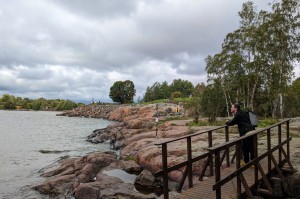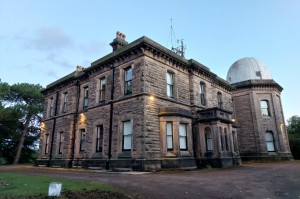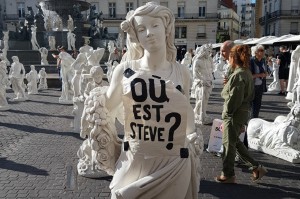Field Trip #14: Frankfurt

Artist Natalie Hughes infiltrates Frankfurt, observing camping punks, art schools, curated balconies and confused Americans …
It’s 9:20 am Frankfurt time on the 14th September and there’s a chill in the air as I make my way to the train station en route to Documenta. Nearing the European Central Bank I hear two loud, croaking giggles coming from Occupy Frankfurt (pictured above); a makeshift campsite near the ECB, whose size is relative to the weather.
I look over to the camp and see two men, one in a ragged suit and another, toothless with an unkempt, greasy mohican. The source of their laughter? A large, fat, grey rat. They’re passing the animal between them; letting it run around their necks and down their jacket sleeves. The haggard punk with the mohican seems particularly fond of the rat. I watch him handle it gently, and give it something like an almost loving smile. I’m beginning to develop a soft spot for Frankfurt, I thought to myself.
The rat looked exactly like this:
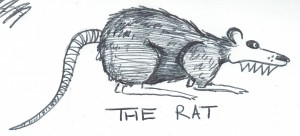
I’d been here for nearly five weeks and I was coming to the end of my internship in the Education and Mediation Department at the Museum für Moderne Kunst Frankfurt. My main job at the MMK had been to help research ideas for the development of their education programme and a discussion about the direction art education in museums and galleries.
Arts Council England funding enabled me to do this internship, and I’d promised ACE that I’d investigate Frankfurt to scope out future possibilities for collaborations or exchanges. In other words, I became a cross between an Art hag and a shit version of Louis Theroux, complete with all the stereotypical English awkwardness and an odd accent, which caused as many problems as it provided inspiration:
“It’s embarrassing for me because technically we speak the same language but sometimes I find it really hard to understand you” – An American.
“Do you have a speech impediment?” – An American.
“Oh you have the English accent I dream of” – A Pole.
“Ahh your accent is beautiful. It’s as if you’re a UNICORN amongst horses. Me and my flatmates like to collect voices on our mail box. If I give you my number will you call and leave a message?” – A (very drunk) German.
The two things Frankfurt is perhaps most famous for is the ECB and the Städelschule (lit-up building on the left, below), their art school. For ease, it is probably the German equivalent of London’s Royal Academy or the Glasgow School of Art, and it is well known for producing high quality, successful artists. So, due to the nature of my mission (it helped if I pretended I was some kind of secret agent), I had to check this place out. I met an American guy called Wendell who was a student there and he agreed to give me a tour around the main building.
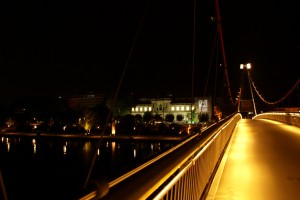
It reminded me a little of my old art school building (Myrtle St. Liverpool) except that this place is in better nick. However, it still has the usual posters for gigs and exhibitions, odd paintings sat in corridor corners and horrible toilets with rude scribbles about excrement.
The studios are good too and accommodate a cooker and a fridge which, when teamed with the 24hr access that the students have, made it seem like a pretty nice place to work. What is even better is that the fees here are only 600 euro a year, which is even cheaper than renting a studio space in Liverpool.
During my tour, Wendell told me some funny stories about the place, which made me miss art school. One tutor believed that she’d been a Spanish man during the time of the Inquisition; another had just got an 18 year-old pregnant in Berlin. Student/Tutor affairs were as good as the norm and Wendell had nearly got himself thrown out of the school for living in his studio and drying out rabbit skins in the attic. My time studying art at Liverpool John Moores seemed boring in comparison … almost: it had its moments.
The Städelschule sports an all-star cast of tutors, which include Simon Starling, Douglas Gordon, Willem de Rooij and Tobias Rehberger and the best way to get in, I’m told, is to find the tutor you want to study under and take them for a drink. This gave me ideas of re-gaining an artistic practice and applying to the Städelschule by turning up with a sack of Proper English Tea for Simon Starling (Germany doesn’t do tea like us and Starling looks like a tea lover) and, as a back up, bottles of whiskey to woo Douglas Gordon.
From what I gathered, the Städelschule seemed to exist in a bit of a 70s art-school bubble and didn’t really have much interaction with the city. Most students leave Frankfurt once they graduate and few stick around to build anything up, which is a shame, because it feels like the art scene here is lacking the DIY energy/element of risk that makes the art scenes in places like Liverpool, Manchester and Birmingham so dynamic.
I think its main problem is the lack of cheap, available space, which places like Northern England or Berlin has in abundance and also, because the city is so small and compact, it’s harder to cut corners and find ‘clever solutions’ like you can in London.
However, there are two studio groups Basis and Atelier Frankfurt that provide affordable studio space and have gallery programmes, which focus on emerging to mid career artists in a similar way to many UK artist-led spaces. I met with the directors of both of these groups to find out more about them and to tell them about what was going on in Liverpool.
These studio groups are far bigger than anything back home; Basis had around 70 members split between two buildings and Atelier Frankfurt something like 40. Looking around these places made me realise just how young the art scene was back at home and how it was still developing.
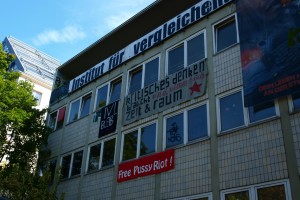
In general, artists rarely get ‘established’ before 35 and in these studio groups nearly everyone was 35 or older. It’s the opposite in Liverpool; the majority of artists being under 35, and this made me hopeful about the future; I thought that if we (Liverpool) carry on as we are, in a few years’ time or so we could be a serious art-hub. I spoke to these two groups about the possibility of setting up an artist exchange, which they liked and Corrina from Atelier Frankfurt said she’d be open to exhibition proposals … anyone fancy a trip to Frankfurt?
Continuing on my search for the elusive art scene/alternative sub culture, I went to visit a squat called the IVI, the Institut für Vergleichende Irrelevanz (Institute for Comparative Irrelevance, above). This place was a stronghold for old-skool lefties, punks and hippies. It was spray painted inside and out with lefty slogans, held weekly parties with an unlicensed bar and played all the kinds of music you’d expect, including Bob Dylan’s The Times They Are A Changing album at 5am as they wound down their Wednesday night session.
It seemed a bit clichéd and idealistic, but maybe that’s because I’m too cynical and English to really believe in anything. I was glad I saw this place, and I think it is a shame something like this doesn’t happen in Liverpool; I hate paying rent. Sadly the IVI has been bought by the real estate company, Franconofurt, and is due to close.
My search for art, artists and interesting projects took me all over Frankfurt, brought me in to contact with many good people and landed me in a few funny situations. Out of all of this the best thing I found was Lampione (below), a small artist-led project ran by ex-Städelschule student Jorma Foth. He uses of the balcony of his bedroom to exhibit a series of banners and flags, which have been made by artists and philosophers. Each month, for 6 months of the year (the project is in its second year), the balcony is home to a new artwork and the artwork from the previous month gets re-housed in the near-by corner-shop, Yop-Yop. Lampione was the only thing that I found that really tried to have a conversation with the city. Also, coming from the DIY, artist-led background that I do, I felt an affiliation with Lampione and saw it as a good antidote to a conservative art scene which seemed to keep itself separate from the rest of the city. Frankfurt needs more Lampiones.
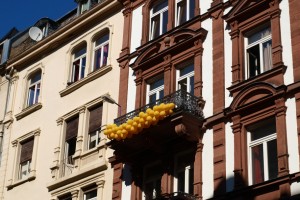
Being in Frankfurt made me realise that Liverpool has the potential to be something really great, not that what is going on isn’t great already, but there’s plenty of room for growth and improvement and I think that there needs to be more artist-led spaces. I am also looking forward to seeing how the Biennial develops under Sally Tallant as she brings a more integrated approach to the festival, involving more of the local art scene and continues to build on the already excellent tradition Liverpool Biennial has for commissioning durational art projects in the public realm. Having an international, contemporary art festival that is so involved with the city and its people is something to be proud of.
Now that I am back I want to set up something along the lines of a residency or exchange programme. I believe that it is important for different artists and art scenes to work in exchange and bring their ideas to new situations. It’s fun too.
Finally, I recommend Frankfurt for a visit. It’s not an easy place and you need to give the city a bit of effort, but it pays off because there are interesting things happening if you’re willing to dig around a bit. It also has a fantastic selection of beautiful museums and galleries and some local delicacies you won’t have heard of but will miss once you leave. I really miss Handkäse.
If you do go I left a pair of rollerblades at the MMK, which you’re welcome to, they’re a size 7. I bought these to skate up and down the Main (the river in Frankfurt) and before you ask, yes it is acceptable for grown women to skate in public in Frankfurt. They were an impulse purchase after the ACE funding came through and have only been used five times.
Natalie Hughes



